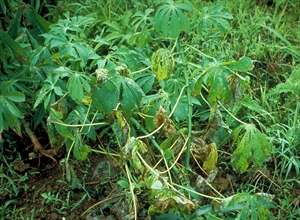- Worldwide distribution. In most cassava-growing countries. On cassava and relatives. A very important bacterial disease.
- Angular dark spots on leaves, with creamy ooze, bordered by veins; the spots expand, merge and form large rots. Bacteria inside the leaves travel to the stems blocking water flow; leaves wilt, die and fall.
- Spread in wind and rain, in cuttings and on tools.
- Cultural control: take cuttings only from healthy plantations; do not plant new plots next to old; 1-2-year crop rotation; clean tools after use (bleach); collect and burn trash after harvest; resistant varieties (see SPC CePaCT for those available).
- Chemical control: none recommended.






